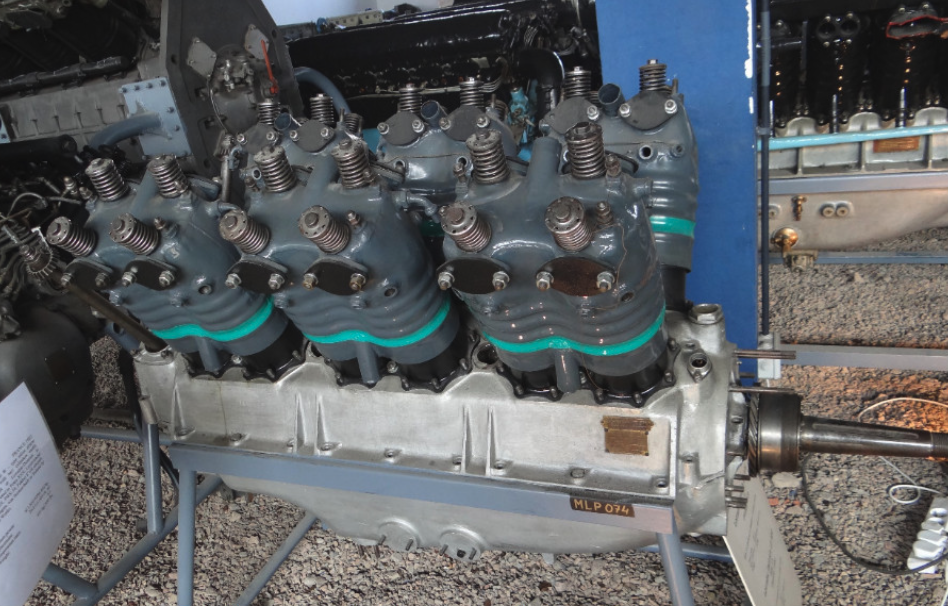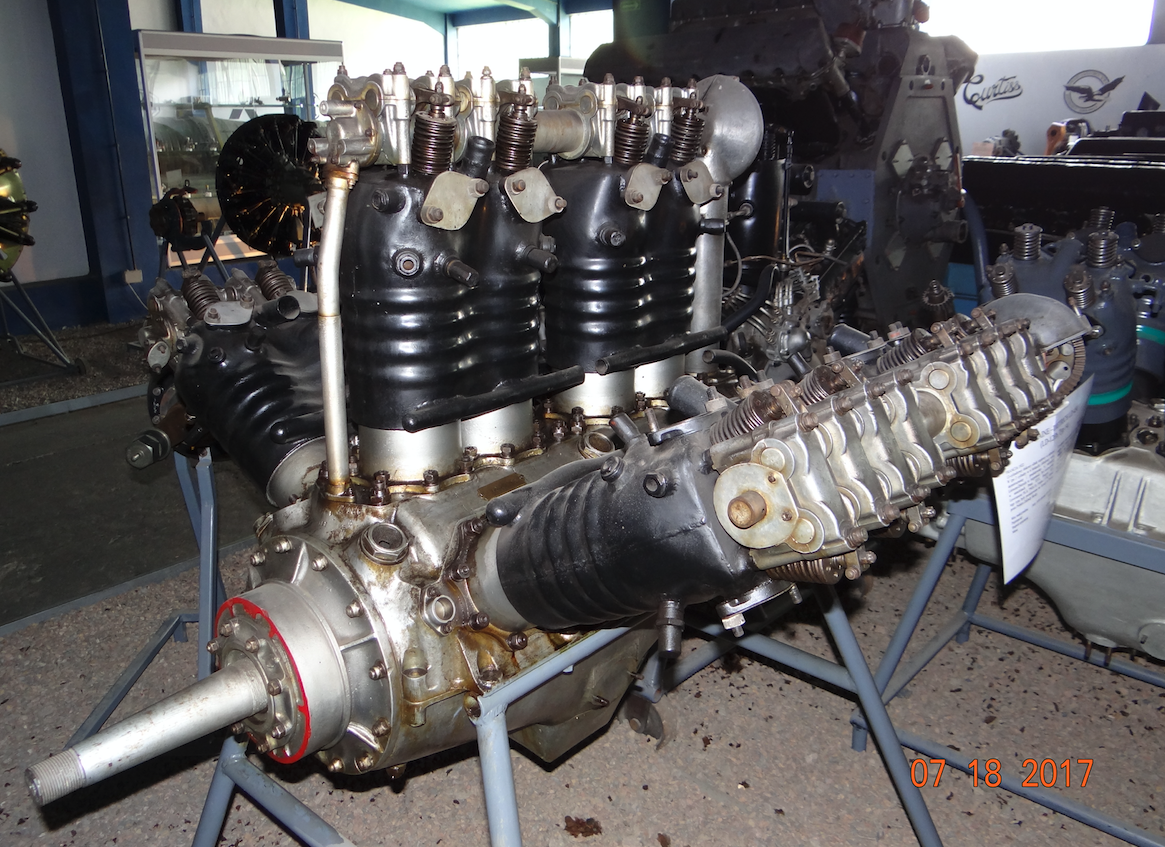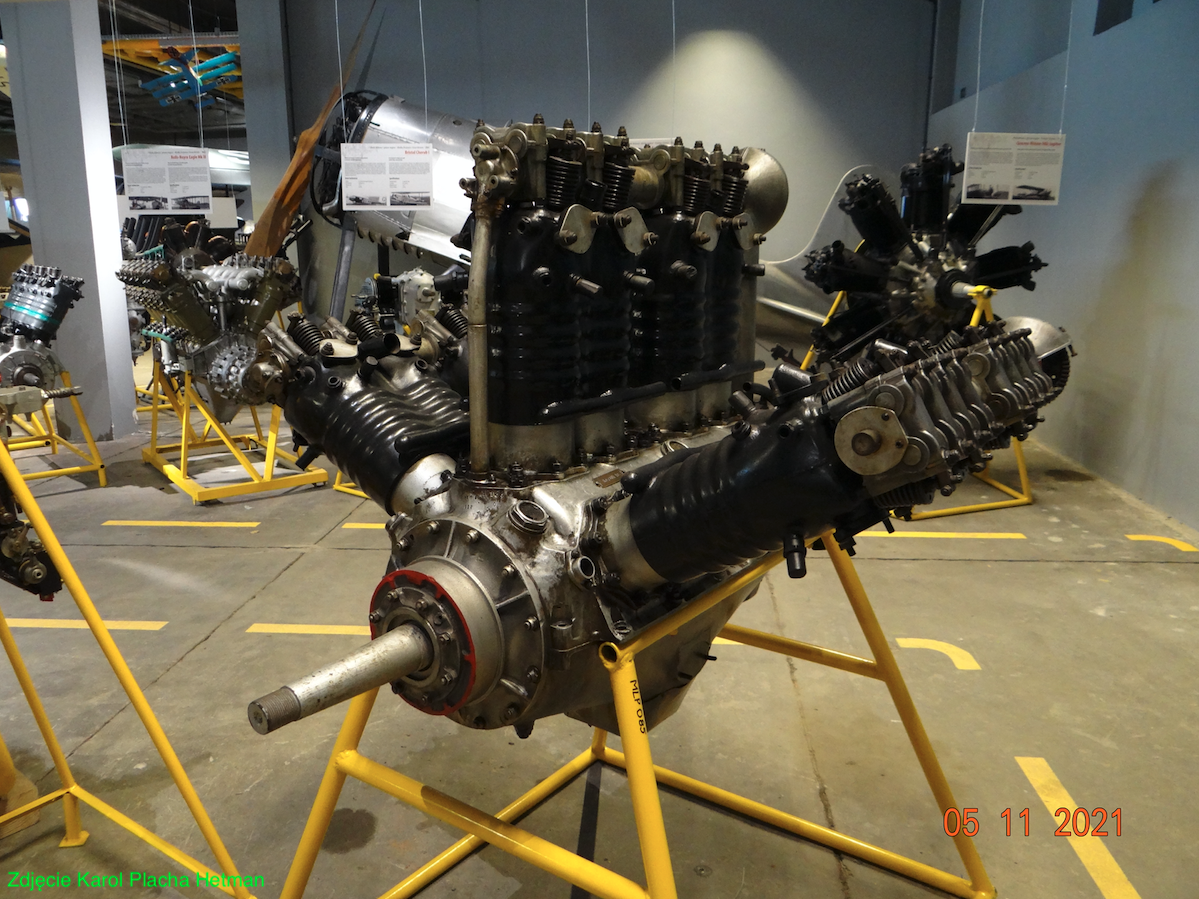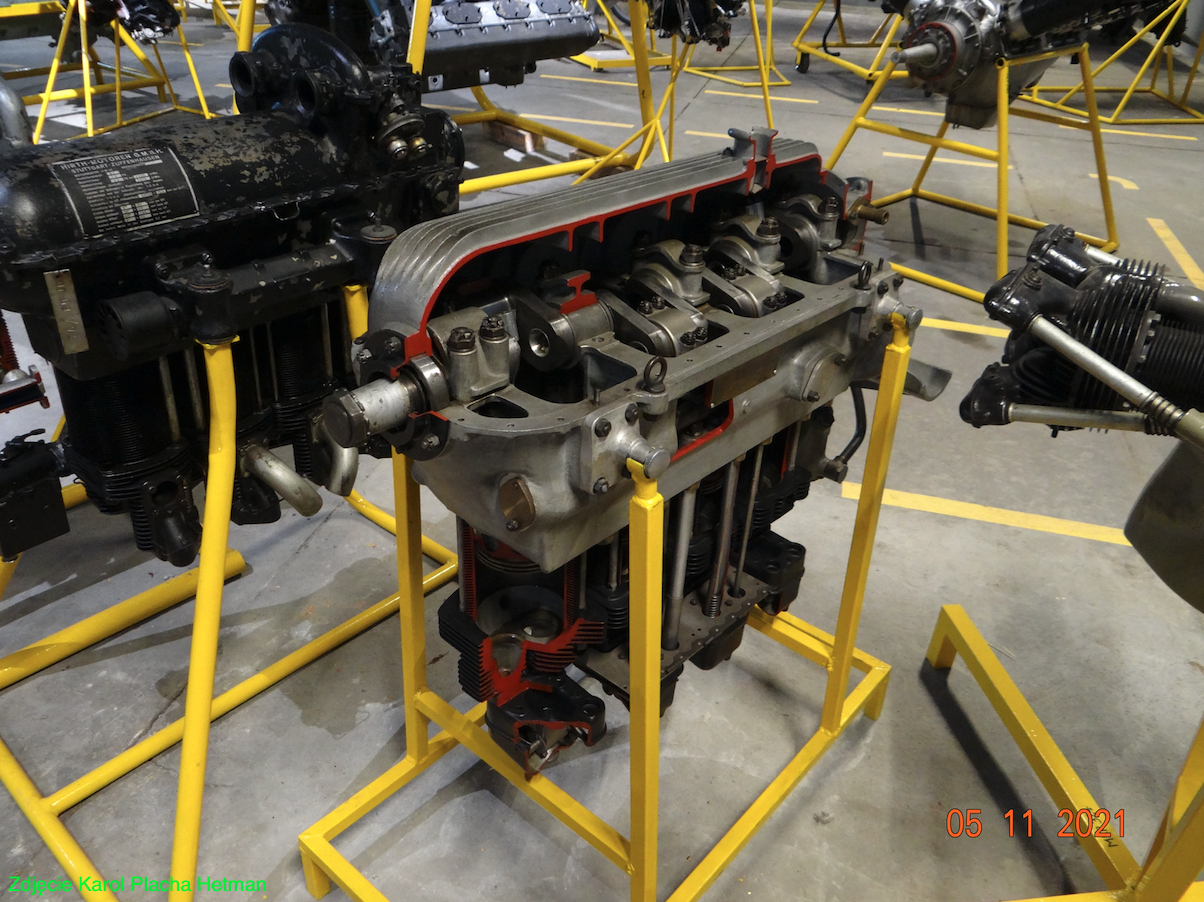Polish inline engines
Lorraine-Dietrich 12.
The Lorraine-Dietrich 12 engine was the first in-line engine built in the Reborn Republic of Poland. Department IV of Air Navigation decided to undertake licensing purchases. To begin with, a license was purchased from French Lorraine-Dietrich engines with 400 HP and 450 HP. In December 1926, an agreement was signed between Skoda Polska and the licensor, Lorraine-Dietrich. As a loan, Lorraine-Dietrich supplied connecting rods, cylinders, timing gear and crankcase. In the period 1928-1930, the Polish Skoda Works built 300 Lorraine-Dietrich 12 engines with a capacity of 450 HP. In later years, only these engines were repaired and spare parts were supplied. The cooperation with Lorraine-Dietrich was terminated due to the switch to the production of air-cooled engines. It was a very good decision, and its initiator was Colonel Ludomił Rayski.
The first engine was the Lorraine-Dietrich LD-400, with a maximum power of 415 HP. The engine was also marked as 12 DB or Type 13. The engine reached its maximum power of 415 HP at 1,800 rpm. The engine was developed in 1920. The engine is a V-type, 12-cylinder, liquid-cooled engine. Each cylinder had two valves and two candles. Two cylinders were combined in one block with one cooling channel system. The cylinders are made of steel and the crankcase is made of aluminum. 23.7 liter displacement. Weight 370 kg. The engine was used, among others, in the following planes: Potez XV, Potez XXVII, Breguet XIX, and Farman F.62 Goliath bomber. Preparations were made for its production, which ultimately was not undertaken with the focus on the more powerful Lorraine-Dietrich LD-450 engine.
The second in-line engine purchased by Poland was the Lorraine-Dietrich LD-450 (LD-12 Eb, Type 14). The engine was developed in 1922 and was built in the W-12 system, it is liquid-cooled, has two valves per cylinder. The cylinders were blocked in pairs in six blocks. The engine reached its maximum power of 450 HP at 1,850 rpm. Engine weight 435 kg, displacement 24.4 liters, compression ratio 6.1. The parent plant for the production of this engine was the plant in Argenteuil in the greater Paris area. In Poland, production was launched at the Skoda Polska plants. The engine was used to power the following aircraft: Potez XXV, Breguet XIX, PWS-10, Fokker F.VII.
Engines of designers Franciszek Peter and Aleksander Seńkowski.
In 1930, Polish constructors Franciszek Peter and Aleksander Seńkowski built a simple in-line 4-cylinder aircraft engine called PZInż PS-II PeterSen with a capacity of 90 HP. The drive was built in PZInż. The air tests were carried out on the WK-3 aircraft. The engine was correct, but it took a long time and money to refine it.
The name PZInż is an abbreviation of Państwowe Zakłady Inżynieryjne. The company was founded on the transformation of the Central Car Workshops on March 19, 1928. The initiator was Eugeniusz Kwiatkowski. The main plant (built in 1933) was located in Warsaw, Praga, at 34/36 Terespolska Street (now Chodakowska Street). In 1935, the company employed approximately 5,500 employees. She was active in the automotive and defense industries. It produced cars, motorcycles, trucks, buses, tanks, artillery tractors and engines. Cars and motorbikes continued to be produced under the CWS brand (Central Car Workshops). In 1930, the company took over the bankrupt Ursus plants. In 1933, the company became a consortium with six factories. The range of finished products and prototypes was huge.
At the beginning of 30 years, a team of aircraft engine designers began working for Skoda Polska. They were Franciszek Peter, Aleksander Seńkowski and Wiktor Narkiewicz. The Avia 3 engine with 63 hp was created. Inverted 4-cylinder in-line engine (crankcase at the top). The structure was built in 1934. The engine was tested on the RWD-16 prototype and the PWS-40 Junak prototype. The engine did not enter serial production.
The same team of designers developed the Avia 4 engine with 100 hp in parallel. Classic 4-cylinder engine. The engine underwent airborne testing but was not put into series production.
PZL Foka.
The Polish in-line engine was the air-cooled PZL Foka engine with a nominal power of 420 HP. High hopes were placed on this engine. In September 1934, engineer Stanisław Nowkuński started working on the Foka engine, which still arouses a lot of emotions. The engine was an 8-cylinder (in the development version it was a 12-cylinder) designed in a reversed V configuration. Starting power 331 kW (450 KM). The Foka engine was to be used to power the PZL-38 Wilk fighter-bomber (according to the concept of Jerzy Dąbrowski, designed by engineer Franciszek Misztal) and the PZL 39 (LWS-4) aircraft. Unfortunately, on July 30, 1936, engineer Stanisław Nowkuński died while climbing the Black Summit in the Slovak Tatras. The tragedy took place before the PZL Foka engine trials began.
The order for the engine from the Polish Army Command was received in the spring of 1934. At this point, the rule applied in Poland was broken that the plane was designed when the engine was ready. Now an airframe and an engine for it were being developed simultaneously. The idea was by all means risky, but possible. And sometimes it is the solutions in the world that have brought very good results. We must also remember that the Germans were ruled by the democratically elected Hitler, who had already trodden all treaties ending the Great World War and was getting ready for another war.
Engineer Stanisław Nowkuński used the system used in the Farman 12a and Ranger V-770 V engines and observed modern solutions introduced in French and American engines. Initially, the engine was a V-8 design, with 420 hp (310 kW) at 4,000 rpm. It was to have a reducer and mechanically coupled supercharger. The compressor was from the Bristol Mercury engine. The weight of the engine with the reducer and compressor was to be 250 kg. The engine covers are made of aluminum sheet. The engine was to move a 2-blade fixed propeller, and ultimately a 3-blade metal propeller with a diameter of 2 m, made by Ratier.
The main work on the new engine began in October 1934. In December 1934, designer engineer Stanisław Nowkuński had ready calculations, selected components and raw materials. The design team included: Jerzy Bełkowski, Kazimierz Księski, Jan Oderfeld, Jarosław Naleszkiewicz and Edward Kotarski. At the beginning of 1935, the Polish Skoda Works were taken over by the state and became WS-1 PZL, therefore the engine was officially named PZL Foka. In early 1936, the project was ready. It was decided to build eight prototypes. After the constructor’s death, work on the program was drastically slowed down. Jan Oderfeld became the new head of the team. In October 1936, the construction of a prototype began. When the first engine was launched, the remaining seven underwent modifications. The engineers (Jan Oderfeld, Włodzimierz Strzeszewski, Jerzy Bełkowski) needed another two years to solve all the problems. The first engine weighed only 210 kg, but its power was only 180 HP (130 kW), which was an unpleasant surprise for the constructors. Thanks to further modifications at the beginning of 1937, the power reached over 350 HP (260 kW). Air tests were carried out. At the end of 1936, engineer Jan Oderfeld announced that the time needed to refine the engine would be longer. In addition, he informed that the engine should be 12 cylinders to keep up with global trends. When in 1938 the PZL Wilk aircraft with PZL Foka engines was demonstrated at the Paris Salon, the engine was still far from mass production. Engine cooling was underdeveloped. There were also carcase cracks. The Polish Army still upheld the order for a minimum of 400 engines. However, the program lost the rulers’ priority because the French companies Hispano-Suiza and Gnome-Rhone offered their new engine models. As a result, work on the PZL Foka engine was slowed down. In addition, the PZL Wilk plane, the main beneficiary of the engine, turned out to be heavier than the plans. Therefore, the PZL Foka V-8 engine turned out to be unnecessary. It was possible to start developing the PZL Foka B V-12 engine, with the power of 700 HP (520 kW), reaching the altitude of 5,000 m. The initial optimism, caused by the assumed simplicity of the transition from the V-8 engine to the V-12 engine, faded quickly. From the PZL Foka A engine, only pistons, cylinders and valves could be adapted. Everything else had to be redesigned. The construction of the first prototype of the PZL Foka B began at the beginning of 1939. Tests were scheduled for 1940, and serial production was to start in 1942. The attack by the German army thwarted intentions before the PZL Foka B prototype was launched.
When discussing the PZL Foka engine, it is worth stopping for a moment when cooling aircraft engines that do not have a liquid cooling system. With radial engines, the problem was solved surprisingly correctly. An aerodynamic cover has been developed that not only directs the air jets properly, but also reduces the aerodynamic drag of the entire structure. During World War II, the correctness of this concept was confirmed by numerous fighters from the USA, Japan, as well as the German Focke-Wulf FW-190.
The case with inline engines was a bit different. Such a cooling system had to be developed individually for each engine. The problem was to effectively circulate air to each cylinder. For PZL Foka, a central cooling air intake was developed, located between the bifurcation of the first cylinders. The shape and size of the air inlet was changed several times. The outlets are located behind each cylinder in the side walls of the engine hood. The use of internal blades and sliding louvers was considered. From the available information, it appeared that the system was working properly and only needed some minor adjustments.
Engines PZInż. Junior, PZInż. Major.
In the second half of the 30-year period, the situation with piston engines for aviation continued to be difficult. There were high hopes for the construction of a new WS-2 engine factory in Rzeszów. Star engines were their main production. Licenses for two low-power engines were also purchased. The first was the engine marked in Poland PZInż. Junior, the second PZInż. Major. These were the licenses of Czech motorcycles by A.S. Walter Tovarny. The production of both engines was launched in 1935 at the Ursus plant, and then at PZL WS-2 in Rzeszów. A total of about 600 were built (500 – Junior, 100 – Major).
PZInż. Junior is a 110 HP engine. The engine is in-line, four-cylinder, with cylinders placed under the crankshaft. Air cooled. Max power 120 HP at 2,300 rpm. Capacity 5.8 dcm3. Compression ratio 5.2. Weight 148 kg. Built without supercharger and reducer. The engine was designed to drive RWD-8 training and liaison aircraft and RWD-10 aerobatic aircraft.
PZInż. Major (120 HP), sometimes called PZInż Major 4. Design similar to the Junior engine. It was intended to power the sports RWD-13, school RWD-17 and PWS-35 aircraft. The engine was produced from 1935 at the Ursus plant. In April 1939, the plant in Rzeszów was able to start mass production. Until the German attack, 50 engines were built in Rzeszów. A total of 100 PZInż Major engines were built.
In the interwar period, no Polish in-line engine could be put into mass production (star yes). There was definitely a shortage of adequate funds and time. We were far from highly developed industries in the USA, UK, France or Italy. And it is not only about good design solutions, but also about the entire metallurgical industry (steel mills, foundries), scientific facilities and flight test and test procedures. However, considering the fact that the Polish Aircraft Engine Industry was created out of nothing, it should not be considered a failure. Several Polish constructions were created that had a chance to enter production. At the end of 30 years, we had three plants producing engines: PZInż Ursus, WS-1 Okęcie, WS-2 Rzeszów and their production capacity was growing. In 1940, WS-2 Rzeszów planned to build a minimum of 500 engines. Steel mills supplied better and better alloys, and foundries gradually obtained good quality products.
Written by Karol Placha Hetman








